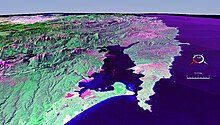Cetacean strandings in Tasmania occur for a number of reasons, with Tasmania considered a "'hotspot" for the event. Between 1825 and 1986, 213 stranding events had been recorded, involving 22 species, and over 3000 individuals.
Causes
Cetacean strandings may occur for a number of reasons. These include natural causes, such as coastal topography and tidal patterns, searching for food, or a change in electromagnetic fields that could disorient them. Other causes include boat strikes, fishing. and pollution, that could result in injuries and stranding. Pilot whales in particular, living in strong social units, sometimes strand themselves to be with family.
Stranding events

2020 long-finned pilot whale stranding
In September 2020, more than 450 long-finned pilot whales stranded in Macquarie Harbour on the western coast of Tasmania, in Australia's worst-ever stranding event. Most were stranded on sandbanks and beaches around the mouth of the harbour. 50 were rescued, with the balance, 380 whales, dying.
2022 pilot and sperm whale strandings
In September 2022, fourteen stranded sperm whales at King Island, most of which appeared to be young males according to the Department of Natural Resources and Environment spokesperson, were dead when they were reported in the afternoon of 19 September 2022.
Two days later, on 21 September, 230 pilot whales, including young, stranded at Macquarie Heads, near to the location of and exactly two years after the 2020 stranding. The remote location made it difficult for rescue teams to reach the whales, with teams from the Environment Tasmania Marine Conservation Program working with the Tasmania Parks and Wildlife Service and Tasmania Police. The West Coast Council urged members of the public to stay clear unless they were invited by the rescue teams to assist, saying that "Having extra people can really hinder how they go about their rescue efforts." Locals have been covering the animals with blankets and pouring buckets of water over them. As of the morning of 22 September, 35 whales were still alive. Tanya Plibersek, Minister for the Environment and Water, wrote on Twitter: "Very distressing to see a large number of whales stranded in Tasmania. Many thanks to the experts and emergency personnel on site to assist efforts."
References
- "Troublesome teenagers? Herd mentality? What we know about why Tasmania has another mass whale stranding". ABC News. 21 September 2022. Retrieved 21 September 2022.
- Nicol, Douglas James. "The Tasmanian Cetacean Stranding Record: A Review of the Cetacean Strandings in Tasmanian Waters and an Examination of Possible Causes" (PDF). University of Tasmania.
- "Tasmania's whale stranding tragedy explained". Australian Geographic. 23 September 2020. Retrieved 21 September 2022.
- "Why do whales beach themselves? We're partially to blame". Animals. 29 March 2021. Archived from the original on 29 March 2021. Retrieved 21 September 2022.
- "380 whales dead in worst mass stranding in Australia's history". the Guardian. 23 September 2020. Retrieved 21 September 2022.
- "Australia says majority of 470-strong beached whale pod has died". Reuters. 23 September 2020. Retrieved 21 September 2022.
- "'It was pretty horrific': Sperm whales stranded off Tasmania mostly young males, experts say". ABC News. 20 September 2022. Retrieved 21 September 2022.
- "Sperm whales die in mass stranding on Australian beach". BBC News. 20 September 2022. Retrieved 21 September 2022.
- Mahony, Jack (21 September 2022). "Shocking pictures reveal extent of stranded whales on Tasmanian beach". Sky News. Retrieved 22 September 2022.
- "Whale stranding: 230 whales stranded on Tasmanian beach". BBC News. 21 September 2022. Retrieved 22 September 2022.
- "Race against time to save whales, with only 35 still alive after 230 beached in mass stranding". ABC News. 21 September 2022. Retrieved 21 September 2022.
- "Rescuers rush to save hundreds of pilot whales stranded on Tasmanian beach". the Guardian. 21 September 2022. Retrieved 21 September 2022.
- "Rescue effort under way after some 230 whales beached in Tasmania". www.aljazeera.com. Retrieved 21 September 2022.